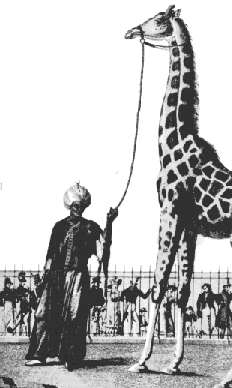

"How the Giraffe Got
Its Neck"
"It is interesting to observe the result of habit in the peculiar shape and size of the giraffe (Camelo-pardalis): this animal, the largest of the mammals, is know to live in the interior of Africa in places where the soil is nearly always arid and barren, so that it is obliged to browse on the leaves of trees and to make constant efforts to reach them. From this habit long maintained in all its race, it has resulted that the animal's fore-legs have become longer than its hind legs, and that its neck is lengthened to such a degree that the giraffe, without standing up on its hind legs, attains a height of six metres (nearly 20 feet)." - Jean Baptiste Lamarck (1809) "Zoological Philosophy"
Lamarck's explanation of the giraffe's neck is a classic "adaptationist" story
[sometimes called "Just
So" stories after those of Rudyard Kipling], a
clever and attractive explanation of the adaptive significance
of a character, which is however not based on any empirical
data. Actual observation of giraffes shows that they
prefer to browse at shoulder height. The extended neck of
giraffes instead appears to be a consequence of sexual selection. Male
giraffes use their neck and head as clubs in agonistic displays
with other males in competition for females: those with thicker
necks and more massive skulls and horns are more successful, and
are the mates preferred by females.
The French verb rendered here as "obliged" is "besoin",
usually translated as "want" or "need". Note the
different implications: a giraffe that "wants" to stretch
its neck has a purpose or goal, whereas one
that "needs" to stretch its neck is satisfying a
mechanical requirement. The former is a teleological argument,
that evolution moves toward an end-point.